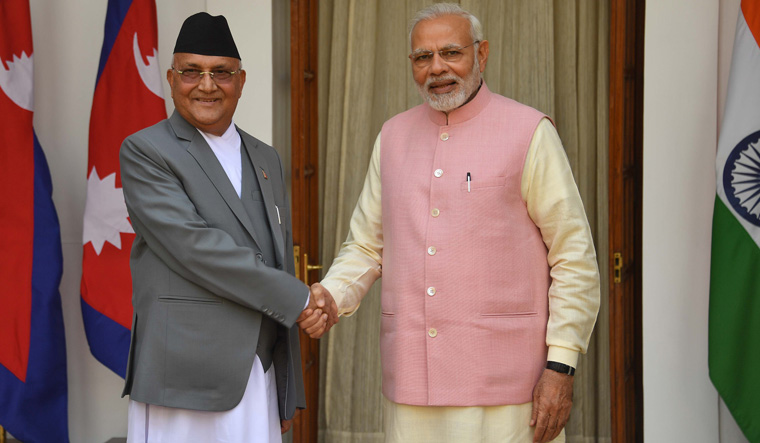
Behind Nepal’s internal squabble, stakes higher for China, India

China is busy in Kathmandu trying to patch up differences in the ruling Nepal Communist Party (NCP) and prevent a split. India is conspicuously absent. It could mean just one thing, that New Delhi has been cut out of the equation. Or, the other obvious implication: that India has ceded its domination over the Himalayan nation to China.
On record Indian External Ministry officials have been quoted by the media as saying the BJP government of Prime Minister Narendra Modi would like to keep out of the internal affairs of its neighbour and it was for Nepal to decide its future course of action.
No doubt India’s stance comes across as almost noble, in allowing Nepal to settle its own problems. But the point is the Chinese have publicly moved into Kathmandu and their top officials have openly declared their mission to broker peace in the ruling dispensation between outgoing prime minister KP Sharma Oli and the co-chairman of the NCP Pushp Kamal Dahal, or Prachanda.
Oli-Prachanda rivalry
Since Oli recommended the dissolution of the House of Representatives last week, Chinese Ambassador Hou Yanqi and a top Communist party official Guo Yezhou have gone about attempting to prevent Oli and Prachanda from splitting.
Incidentally, the Left alliance comprising Oli’s United Marxist-Leninist Party and Prachanda’s Communist Party of Nepal (Maoist) was elected in 2018. Under Chinese prodding, they combined to form one entity – the Nepal Communist Party. It is this that Beijing is now trying to prevent from falling apart.
Obviously, therefore, Nepal is not handling the internal crisis on its own free will. So the Indian government’s contention it does not want to intervene sounds more like making a virtue out of necessity, of being kept out of action.
Also read: Nepal PM Oli recommends Parliament dissolution; opposition cries foul
New Delhi losing ground
What this could mean is that India appears to have lost its centrestage presence in Nepal. For years, right from India’s independence when Nepal was ruled by a monarchy, the Jawaharlal Nehru government followed by all its successors had a hand in firmly deciding its destiny.
India continued to play a considerable role even after the monarchy was replaced by a republic in 2008. Until the Modi government, it was a well-acknowledged fact that nothing would move in Kathmandu without New Delhi’s concurrence.
The Indian government, under the BJP, burnt its bridges with Nepal by enforcing the economic blockade in 2015, an action that allowed China to enter and occupy key political space in that country. The dominance of the communists in Nepal and the coming to power of their ideological rivals, the BJP, in India proved by default to be to Beijing’s advantage.
Moreover, India faced a sort of anti-incumbency in Nepal having played a dominant role there for close to seven decades. In the past while various governments and political parties in Nepal have always tried to be on the right side of New Delhi, a section of Nepalis resented India’s “big brother” role.
Post-monarchy scenario
Top Communists like Prachanda and Oli made sure they humoured New Delhi and frequently made politically correct statements to indicate their closeness to India. During the movement against Nepal’s monarchy, the higher echelons including Prachanda used India as a safe haven from where to carry attacks against the kingdom.
Though ideologically closer to China, in practical terms, Nepal’s communists had fraternal relations with their Indian counterparts, but never got involved in India’s Maoist movement lest they antagonised New Delhi during the Congress era.
Once monarchy was overthrown and Nepal emerged as a secular, democratic republic, the communists have gradually moved away from India’s orbit. Even if the communists have occasionally made deferential statements in favour of New Delhi, that cannot be taken to be an indication of closeness to the Indian establishment.
Also read: India sees itself as Nepal’s foremost friend and development partner, says Shringla
After the India-imposed blockade in 2015, the NCP leadership under Oli has bordered on being hostile, marked more recently by its challenge to the ownership of the Lipulekh-Kalapani-Limpiyadhura triangle. Moving unilaterally, the Oli government in June 2020 even altered Nepal’s map to constitutionally incorporate the Kalapani triangle into its map by getting an amendment passed in Parliament.
The Indian government, therefore, would strategically hope that the NCP splits as that will weaken the communist stranglehold in that country. For China, it is imperative that the NCP does not split as it may go against Beijing’s interests. That is the tussle we are seeing now in Kathmandu.
Fluid situation
If New Delhi is making any discreet moves to further its interests in Nepal, it is not immediately apparent. In the event Prachanda and Oli do split, that would result in a three-way contest for power with the largely pro-India Nepali Congress party back in contention.
Compared to the communists, the Nepali Congress has more often been pro-New Delhi. India’s deep state would feel far more comfortable dealing with the Congress. The fracturing of the support across three different groups (in case the NCP splits) will ensure that the Nepali Congress will either be in government or turn kingmaker. Either way, it is good news for India.
There are imponderables, however. For one, the Nepali Congress’s perceived proximity to New Delhi cannot be taken for granted as the country is now a full-fledged republic and it is not clear how the party views India after the 2015 economic blockade.
One thing is clear though. The intraparty squabble within the NCP has larger consequences for relationship with its two “big brothers” to the north and south, which are constantly breathing down Kathmandu’s corridors of power.

